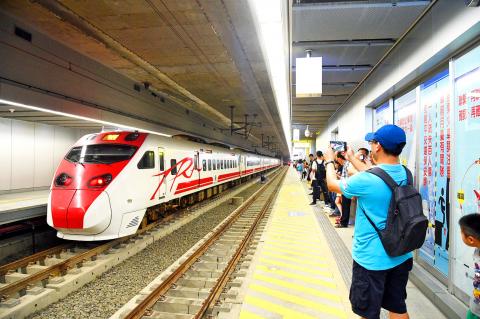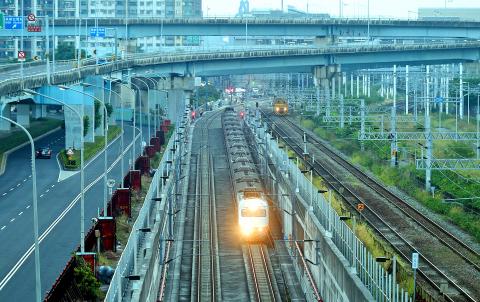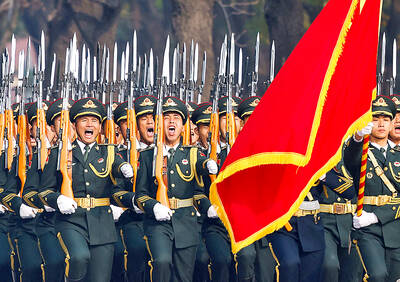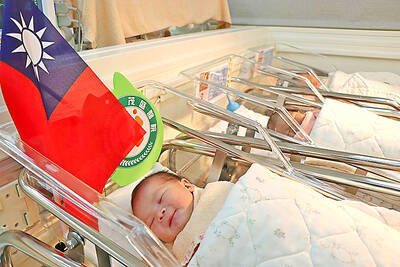An underground railway line officially opened in Kaohsiung yesterday following almost 10 years of construction, the Ministry of Transportation and Communications’ Railway Bureau said.
The line would eliminate all ground-level railway tracks in downtown Kaohsiung, as well as seven railway crossings and 16 flying junctions, it added.
The opening of the line and the new Kaohsiung Railway Station was marked at a ceremony attended by Premier William Lai (賴清德), Presidential Office Secretary-General Chen Chu (陳菊), Minister of Transportation and Communications Wu Hong-mo (吳宏謀) and Railway Bureau Director-General Allen Hu (胡湘麟).

Photo: Chang Chung-yi, Taipei Times
Lai thanked the construction team for their hard work over the years, as well as Kaohsiung residents who put up with the construction for the past decade.
The central government and the Kaohsiung City Government should continue working together to finish the project’s second phase, which includes building a “green corridor” using the land previously occupied by railroad tracks and commercial buildings at the Kaohsiung and Fengshan railway stations, Chen said.
Eliminating railway crossings and junctions would improve the traffic in downtown Kaohsiung and reduce traffic accidents caused by trains, Wu said.

Photo: Chang Chung-yi, Taipei Times
The project also helps to connect areas previously divided by railway tracks, balance the development of different districts in the city, raise land values and improve city residents’ quality of life, he said.
Hu pointed to the difficulties faced while building the underground railway line, which passes under the Love River (愛河).
The most challenging part of construction was the new Kaohsiung Railway Station, which would be used by the Taiwan Railways Administration (TRA) as well as the Kaohsiung MRT system, he said.
The two systems had to continue operating during the construction of the new line, which proved to be challenging, Hu said.
The underground line between Zuoying (左營) and Fongshan (鳳山) is 15.37km long, the bureau said.
It connects 10 railway stations, including Zuoying, Kaohiung, Fongshan and seven new railway stations built for commuters, it added.
The TRA originally planned to launch the new line at 6am, but the first southbound train did not depart from Zuoying until 6:18am and the first northbound train did not leave the terminal station until 6:45am.
One of the railway signals along the northbound line between the Museum of Arts Station and Zuoying malfunctioned at 6:46am, affecting four trains and about 1,890 passengers, the TRA said, adding that the signal was repaired at 7:40am.
In related news, the TRA is on Thursday to release its railway calendar for next year, featuring scenes captured along the railway line between Hualien and Taitung.
The railway agency said that it would only print 1,000 calendars, adding that people can buy them in Taipei Railway Station, as well as Songshan, Nangang, Taichung, Hualien and Kaohsiung stations.

Conflict with Taiwan could leave China with “massive economic disruption, catastrophic military losses, significant social unrest, and devastating sanctions,” a US think tank said in a report released on Monday. The German Marshall Fund released a report titled If China Attacks Taiwan: The Consequences for China of “Minor Conflict” and “Major War” Scenarios. The report details the “massive” economic, military, social and international costs to China in the event of a minor conflict or major war with Taiwan, estimating that the Chinese People’s Liberation Army (PLA) could sustain losses of more than half of its active-duty ground forces, including 100,000 troops. Understanding Chinese

The Ministry of Foreign Affairs (MOFA) yesterday said it is closely monitoring developments in Venezuela, and would continue to cooperate with democratic allies and work together for regional and global security, stability, and prosperity. The remarks came after the US on Saturday launched a series of airstrikes in Venezuela and kidnapped Venezuelan President Nicolas Maduro, who was later flown to New York along with his wife. The pair face US charges related to drug trafficking and alleged cooperation with gangs designated as terrorist organizations. Maduro has denied the allegations. The ministry said that it is closely monitoring the political and economic situation

UNRELENTING: China attempted cyberattacks on Taiwan’s critical infrastructure 2.63 million times per day last year, up from 1.23 million in 2023, the NSB said China’s cyberarmy has long engaged in cyberattacks against Taiwan’s critical infrastructure, employing diverse and evolving tactics, the National Security Bureau (NSB) said yesterday, adding that cyberattacks on critical energy infrastructure last year increased 10-fold compared with the previous year. The NSB yesterday released a report titled Analysis on China’s Cyber Threats to Taiwan’s Critical Infrastructure in 2025, outlining the number of cyberattacks, major tactics and hacker groups. Taiwan’s national intelligence community identified a large number of cybersecurity incidents last year, the bureau said in a statement. China’s cyberarmy last year launched an average of 2.63 million intrusion attempts per day targeting Taiwan’s critical

AGING: As of last month, people aged 65 or older accounted for 20.06 percent of the total population and the number of couples who got married fell by 18,685 from 2024 Taiwan has surpassed South Korea as the country least willing to have children, with an annual crude birthrate of 4.62 per 1,000 people, Ministry of the Interior data showed yesterday. The nation was previously ranked the second-lowest country in terms of total fertility rate, or the average number of children a woman has in her lifetime. However, South Korea’s fertility rate began to recover from 2023, with total fertility rate rising from 0.72 and estimated to reach 0.82 to 0.85 by last year, and the crude birthrate projected at 6.7 per 1,000 people. Japan’s crude birthrate was projected to fall below six,